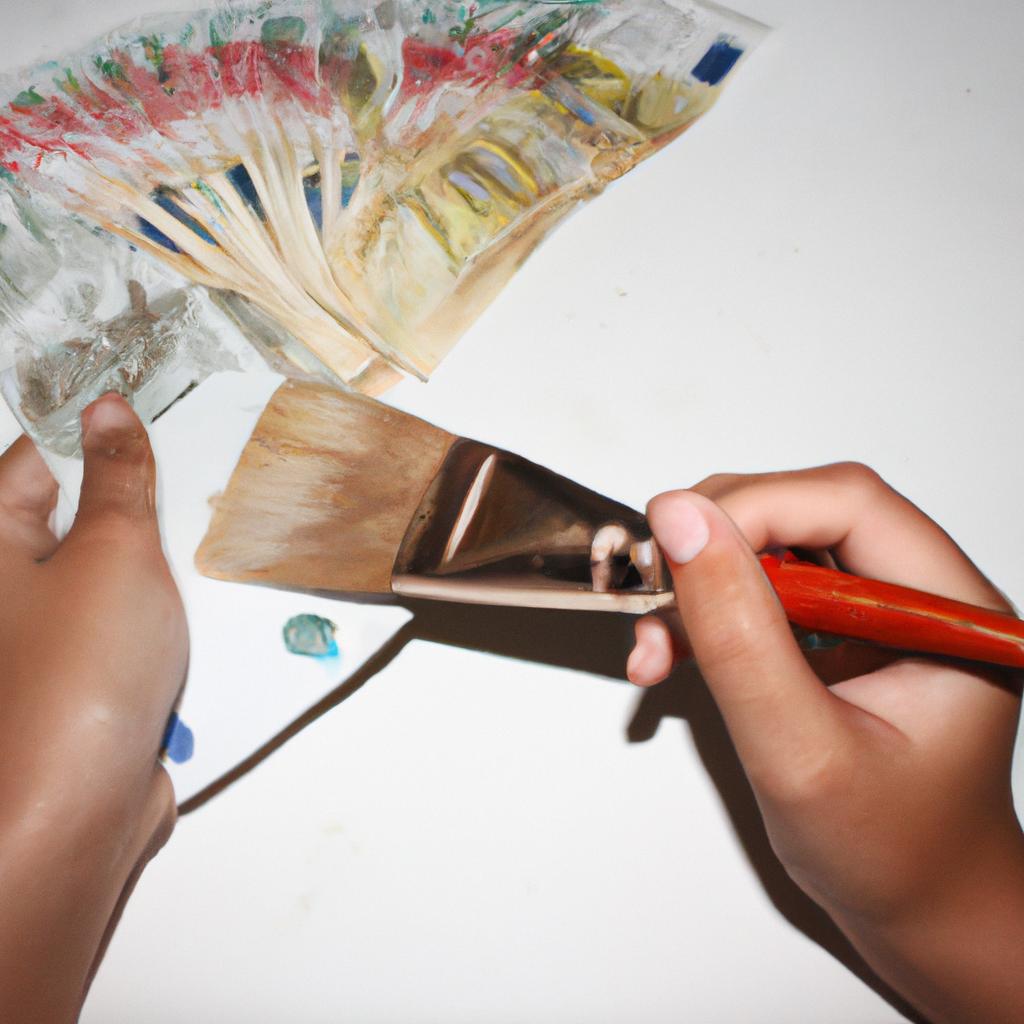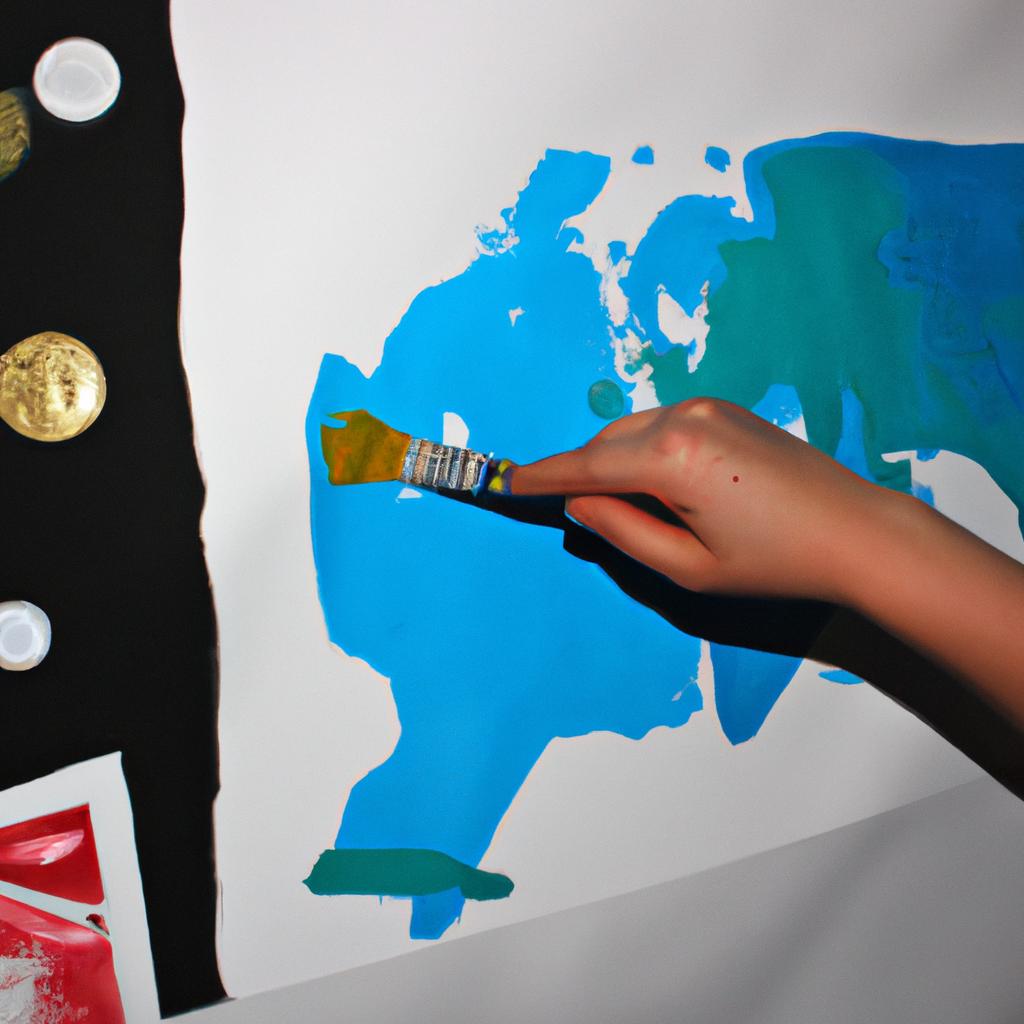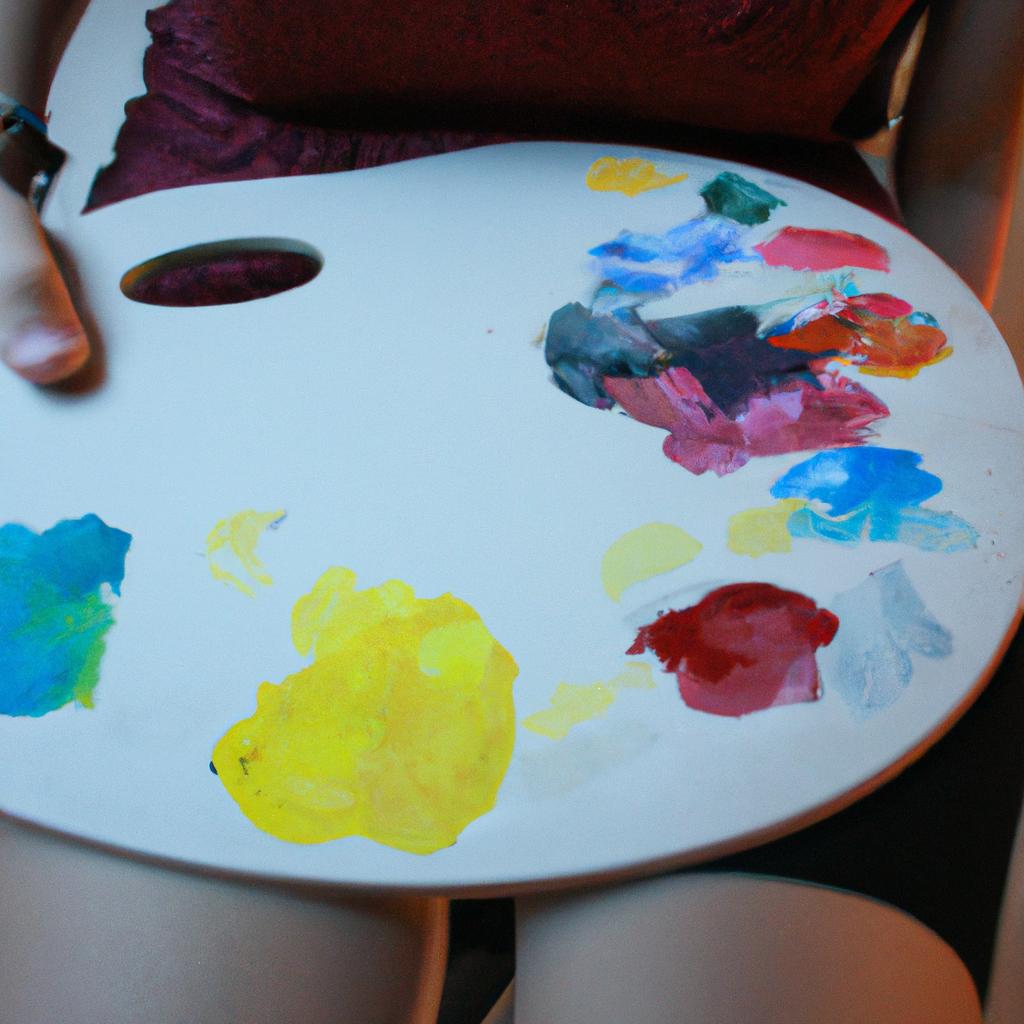The field of arts and illustration is known for its creativity, but when it comes to financial planning, artists often face unique challenges. This article aims to explore the concept of creative finance and how it can be applied in the context of financial planning for artists in arts and illustration. To illustrate this further, let’s consider a hypothetical scenario where an aspiring illustrator named Sarah is struggling with managing her finances while pursuing her passion.
Sarah, like many other artists, faces uncertainty when it comes to income stability. Her irregular cash flow makes budgeting difficult and creates a sense of insecurity about her financial future. Additionally, she may encounter difficulties finding traditional financing options due to the nature of her work. These challenges highlight the need for creative approaches to financial planning that cater specifically to the needs and circumstances of artists in the arts and illustration industry.
In this article, we will delve into various strategies that artists can employ to navigate these financial obstacles effectively. We will discuss methods such as diversifying income streams through freelance work or selling artwork online, creating a realistic budget that accounts for fluctuating earnings, exploring alternative funding sources like grants or crowdfunding platforms, and seeking professional guidance from experts who specialize in working with creatives. By implementing these creative finance techniques tailored to their specific artistic endeavors , artists like Sarah can gain more control over their finances and achieve a greater level of financial stability in their careers.
Diversifying income streams is an essential strategy for artists. By taking on freelance work or selling artwork online, artists can supplement their irregular income from their primary artistic pursuits. This not only provides a steady cash flow but also allows them to showcase their skills to a broader audience and potentially attract new clients or opportunities.
Creating a realistic budget that considers the fluctuations in earnings is crucial for artists. Understanding one’s average monthly income and expenses can help identify areas where spending can be adjusted during lean months. It is important to prioritize essential expenses while setting aside funds for savings or emergency funds to provide a safety net during periods of lower income.
Exploring alternative funding sources is another creative finance technique that can benefit artists. Grants specifically designed for artists, crowdfunding platforms, and even sponsorship opportunities can provide additional financial support for projects or personal development. Artists should research and apply for relevant grants and explore crowdfunding campaigns through platforms tailored to the arts community.
Seeking professional guidance from experts who understand the unique challenges faced by artists in financial planning is highly recommended. Financial advisors with experience working with creatives can offer insights into tax strategies, retirement planning, investment options, and other specific considerations that cater to the needs of artists in arts and illustration.
In conclusion, creative finance plays a vital role in addressing the unique financial challenges faced by artists like Sarah in arts and illustration. By diversifying income streams, creating realistic budgets, exploring alternative funding sources, and seeking professional guidance, artists can overcome these challenges and achieve greater financial stability while pursuing their passion.
Understanding the financial challenges in the arts industry
Understanding the Financial Challenges in the Arts Industry
The arts industry offers unique opportunities for individuals to express their creativity and passion. However, it also presents distinct financial challenges that artists must navigate. One example of these challenges is the irregular income streams experienced by many artists. Unlike traditional careers with a steady paycheck, artists often rely on sporadic project-based payments or sales of their artwork. This variability can make budgeting and financial planning particularly challenging.
To further explore the financial challenges faced by artists, we can consider several key factors:
- Income Volatility: The unpredictable nature of artistic work means that artists may experience periods of high demand and financial success, followed by leaner times where they struggle to secure new projects or buyers.
- Lack of Benefits: Many artists are self-employed or freelancers, which means they do not have access to employer-provided benefits like health insurance or retirement plans.
- Competitive Market: The arts industry is highly competitive, making it difficult for artists to establish themselves and command higher prices for their work.
- Expensive Materials: Artists often need to invest in costly materials such as paintbrushes, canvases, or digital equipment, which can put a strain on their finances.
These factors highlight just some of the obstacles that artists face when managing their finances. To better understand this landscape, let us examine them through an emotional lens:
- Income Anxiety: Artists may constantly worry about whether they will be able to meet their financial obligations due to inconsistent income streams.
- Financial Insecurity: Without employee benefits or stable employment contracts, artists may feel financially vulnerable and uncertain about their long-term stability.
- Struggling for Recognition: The competitive nature of the arts industry can leave artists feeling undervalued and underpaid despite their talent and hard work.
- Balancing Passion with Practicality: Pursuing one’s artistic passions while also ensuring financial stability requires careful juggling between creative pursuits and financial responsibilities.
In conclusion, the arts industry presents unique financial challenges that artists must grapple with. Understanding these challenges is crucial for developing effective financial planning strategies to overcome them.
Identifying key financial goals as an artist
Understanding the financial challenges in the arts industry is crucial for artists who want to achieve financial stability and success. One example of such a challenge is the irregular income that many artists experience. For instance, let’s consider an illustrator named Sarah who works as a freelance artist. While she may have periods where she receives multiple commissions and earns a substantial amount of money, there are also times when she struggles to find clients or secure new projects.
To effectively address these challenges, it is important for artists to identify key financial goals. These goals will serve as guideposts on their journey towards financial stability and success. Here are some common financial goals that artists often strive for:
- Building an emergency fund: Having a safety net of savings can provide peace of mind during leaner months or unexpected expenses.
- Managing cash flow: Artists need to develop strategies to balance their income and expenses throughout the year, ensuring they can cover necessary costs even during slower periods.
- Investing in professional development: Continuous learning and skill improvement are essential in staying competitive within the art industry.
- Planning for retirement: Since many artists don’t have access to employer-sponsored retirement plans, it becomes vital for them to proactively save and invest for their future.
| Financial Goals | Importance |
|---|---|
| Emergency Fund | High |
| Cash Flow | Medium |
| Professional Development | High |
| Retirement Plans | Medium-High |
By recognizing these financial goals, artists can prioritize their efforts accordingly and make informed decisions about how to allocate their resources. This approach helps create a sense of direction and purpose while navigating the unique challenges faced by those pursuing careers in art.
Transitioning into the subsequent section about “Exploring different income streams for artists,” it is important for artists not only to set clear financial objectives but also diversify their sources of income. By doing so, they can mitigate some of the risks associated with the irregularity of artistic work and expand their financial opportunities.
Exploring different income streams for artists
Identifying key financial goals as an artist is crucial for effective financial planning. By setting clear objectives, artists can better understand their financial needs and create a roadmap to achieve them. One example of a financial goal for an artist could be saving enough money to purchase high-quality art supplies or equipment necessary for their craft.
To help artists identify their financial goals, consider the following points:
- Assess current financial situation: Artists should evaluate their income, expenses, assets, and liabilities to gain a comprehensive understanding of their finances.
- Set short-term and long-term goals: Artists may have different aspirations such as paying off debts, building an emergency fund, or saving for retirement. Setting both short-term and long-term goals will provide a sense of direction.
- Prioritize goals based on importance: It is important to prioritize financial goals based on urgency and significance. This can help in allocating resources effectively.
- Make goals specific and measurable: Clearly define each goal with specific targets and establish milestones along the way to track progress.
Now let’s explore different income streams that artists can tap into to diversify their earnings.
Exploring different income streams for artists
Artists often face irregular income due to the nature of their work. Diversifying one’s income streams can provide stability and enhance overall earning potential. Consider the following possibilities:
| Income Stream | Description | Pros |
|---|---|---|
| Selling artwork | Generating revenue through selling original pieces or prints | Provides direct income from artistic creations |
| Commissions | Accepting commissions from clients | Allows customization while generating additional income |
| Licensing | Granting permission to use artwork in exchange for royalties | Offers passive income over time |
| Teaching | Conducting art classes or workshops | Shares skills while earning supplementary income |
By engaging in multiple income streams, artists can not only increase their financial stability and security but also gain exposure to different opportunities within their field. This approach allows artists to explore various avenues for showcasing their talent while supporting themselves financially.
As artists continue to develop their skills, it is essential to manage their finances effectively.
Budgeting and managing expenses effectively
Exploring different income streams for artists can be a crucial aspect of financial planning. By diversifying their sources of revenue, artists in the field of arts and illustration can ensure a stable and sustainable income flow. Let’s consider an example to illustrate this point.
Imagine an artist named Sarah who primarily creates illustrations for children’s books. While she enjoys her work, Sarah understands that relying solely on book illustrations may limit her earning potential. To expand her income streams, she decides to explore various avenues within her profession.
Firstly, Sarah starts offering commissioned artwork services to clients. This allows her to cater to individual requests while showcasing her unique artistic style. Additionally, she begins exhibiting and selling her original artworks at local galleries and online platforms, such as art marketplaces or social media networks dedicated to artists.
Secondly, Sarah leverages digital platforms by creating instructional videos or tutorials related to art techniques and processes. She monetizes these resources through subscriptions or ad revenue on platforms like YouTube or Patreon. This not only generates additional income but also establishes her expertise in the industry.
Lastly, Sarah collaborates with other creative professionals on projects that intersect with her skills, such as graphic designers, advertising agencies, or even filmmakers requiring storyboard illustrations. These collaborations open doors to new opportunities and help broaden both her network and portfolio.
By diversifying her income streams in this way, Sarah ensures a more secure financial foundation while expanding her presence within the arts community. This approach has proven effective for many artists seeking stability in their careers.
To further emphasize the importance of exploring diverse income streams for artists’ financial well-being, consider the following bullet points:
- Multiple sources of income provide stability during lean periods.
- Diversification expands professional connections and networking possibilities.
- Exploring varied avenues helps develop new skills and enhances creativity.
- Different income streams allow for greater control over pricing and negotiation power.
Now let’s look at a table highlighting some examples of diverse income streams for artists:
| Income Stream | Description | Potential Earnings |
|---|---|---|
| Commissions | Creating customized artwork based on client requests | Varies |
| Art Sales | Selling original artworks through galleries or online markets | Varies |
| Instructional Videos | Monetizing tutorials and art-related content | Subscriptions/Ads |
| Collaborations | Working with other professionals in creative projects | Project-based |
As we can see, exploring different income streams not only provides financial stability but also offers opportunities for growth and professional development. With a diversified approach to earning revenue, artists like Sarah can ensure a resilient career within the arts and illustration industry.
Moving forward, let’s now delve into the topic of budgeting and managing expenses effectively, which is essential for artists seeking financial success. However, before discussing this aspect, it is important to understand investment options for artists to build wealth.
Investment options for artists to build wealth
Having established the importance of budgeting and managing expenses effectively, let us now explore investment options for artists to build wealth.
Investing is a crucial aspect of financial planning that can help individuals grow their wealth over time. Artists face unique challenges when it comes to investing, as their income may be irregular or unpredictable. However, with careful consideration and informed decision-making, artists can create an investment strategy tailored to their needs and goals.
To illustrate this point, consider the case study of Emma, a freelance illustrator who wants to invest her earnings to secure her future while continuing her artistic pursuits. Emma decides to allocate a portion of her monthly income towards investments and seeks guidance on where to begin.
Here are some key investment options that artists like Emma can consider:
- Stocks and Bonds: Investing in stocks allows individuals to become partial owners in companies, potentially earning dividends from profits or selling shares at a higher price in the future. Bonds provide fixed-income securities issued by governments or corporations, offering regular interest payments until maturity.
- Mutual Funds: These professionally managed investment vehicles pool money from multiple investors to buy diversified portfolios consisting of various assets such as stocks, bonds, or both.
- Real Estate: Purchasing properties or investing in real estate investment trusts (REITs) provides opportunities for long-term growth through rental income and property value appreciation.
- Retirement Accounts: Contributing to retirement accounts like Individual Retirement Accounts (IRAs) or Simplified Employee Pension Plans (SEPs) enables tax advantages while saving for the future.
| Investment Options | Key Features |
|---|---|
| Stocks and Bonds | – Potential for capital appreciation – Dividend income potential – Higher risk compared to other investments |
| Mutual Funds | – Diversification across multiple assets – Professional management – Lower initial investment requirement compared to individual stocks |
| Real Estate | – Rental income potential – Property value appreciation – Long-term investment |
| Retirement Accounts | – Tax advantages – Savings for retirement years |
By diversifying her investments across these options, Emma can mitigate risk and potentially maximize returns. It is important to note that the selection of investment options should align with an artist’s financial goals, risk tolerance, and time horizon.
As artists explore investment opportunities to build wealth, it is essential to also consider tax planning strategies that can optimize their financial outcomes. In the following section, we will delve into various tax-efficient methods specifically designed for artists.
Tax planning strategies for artists
Investment Options for Artists to Build Wealth
Building wealth is an essential aspect of financial planning for artists in the arts and illustration field. By making wise investment choices, artists can secure their financial future and create a solid foundation for themselves. Let us explore some investment options that can help artists grow their wealth.
One example of an investment option suitable for artists is investing in stocks. Stocks allow individuals to own a share of a company’s ownership, enabling them to participate in its growth and success. For instance, let’s consider an artist who invests $10,000 in stocks of a prominent art supply company. Over time, if the company performs well and experiences stock price appreciation, the artist could potentially see significant returns on their initial investment.
To further illustrate the various investment opportunities available to artists, here are four notable options:
- Real Estate Investment Trusts (REITs): REITs provide investors with exposure to real estate assets without requiring them to directly purchase properties. This option allows artists to diversify their portfolio by investing in commercial or residential properties.
- Mutual Funds: Mutual funds pool money from multiple investors to invest in diversified portfolios of stocks, bonds, or other securities. Artists can benefit from professional management and access to a wide range of investments through mutual funds.
- Exchange-Traded Funds (ETFs): Similar to mutual funds, ETFs offer investors exposure to diverse asset classes but trade like individual stocks on exchanges. These low-cost investment vehicles provide flexibility and liquidity for artists looking to build wealth over time.
- Peer-to-Peer Lending: With peer-to-peer lending platforms, artists have the opportunity to lend money directly to individuals or businesses while earning interest on their loans. This alternative investment avenue allows artists to support others within their creative community while generating passive income.
Consider this table outlining the key features of these investment options:
| Investment Option | Description | Advantages |
|---|---|---|
| Stocks | Ownership in a company’s growth and success | Potential for high returns |
| REITs | Exposure to real estate assets without direct ownership | Diversification, regular income |
| Mutual Funds | Professionally managed diversified portfolios | Access to a wide range of investments |
| ETFs | Trades like individual stocks on exchanges | Flexibility, liquidity |
By exploring these investment options and understanding their advantages, artists can make informed decisions that align with their financial goals. It is crucial for artists to carefully assess risk tolerance, time horizon, and seek professional advice when necessary.
In summary, investing wisely is an integral part of financial planning for artists looking to build wealth. By diversifying their portfolio through various investment options such as stocks, REITs, mutual funds, and ETFs, artists have the potential to grow their wealth over time while supporting their creative endeavors. Remember to consider your specific circumstances and consult with professionals before making any investment decisions.
 PSP Oste
PSP Oste



